|
Foreign
organic products find it difficult to enter Vietnam
The Vietnamese organic product market,
which includes both food and non-food, has been taking shape in the last few
years, but there are still few importers of organic products.
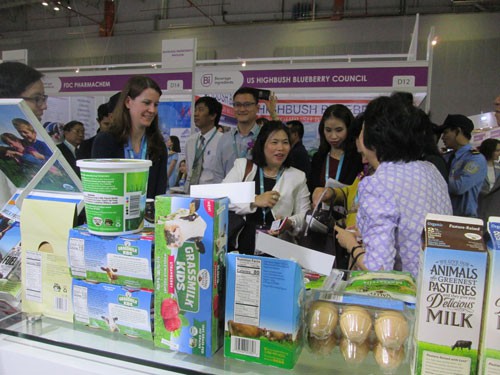
There are still few
importers of organic products
Most of the products are carried to Vietnam across
border gates. Customers have to buy products at high prices, and cannot enjoy
post-sale services.
Organic communities like ‘tieu dung huu co’ (organic consumption’ and ‘song huu co’ (organic life) on the internet and Facebook share knowledge about organic agriculture and also sell organic products. However, the bills issued by shops overseas are the only evidence that prove the ‘organic’ characteristic of products in some cascades.
Sometimes, when supermarkets overseas run sale
promotion programs, the members of the communities order in groups to share
shipping fees.
At a high-end food shop on Nguyen Thi Minh Khai street in district 1, HCM City, next to shelves displaying products imported through official channel which have sub-labels in Vietnamese with sufficient information, there is a shelf for organic products imported through unofficial channels. Reporters noted that most of the products are organic spices with little information about names and selling prices. Detailed information is written in Japanese. Buyers have to rely on information provided by sellers or have to search for information on the internet. The representative of Thien An Le Trade & Service Company in HCMC, which specializes in ‘non-chemical products’, said the company is one of a few retailers which sell officially imported products. There are only a few importers which import these products. These include NTP, which specializes in importing dairy products, grains and cooking oil. Solomon specializes in organic dairy products and Fire Phoenix in cosmetics. Meanwhile, most imports don’t have documents to show their origin. According to Pham Phuong Thao, managing director of Organica which owns Organica shops, the Vietnamese organic food market is still small. Some companies only import products in small quantities. Phan Thi Hong Quyen, co-founder of Solomon International, the exclusive distributor of Organic Valley, said it took two years to negotiate with Organic Valley to obtain the right to distribute its products. However, Quyen complained that the import procedures are complicated and the import tariff on dairy products from the US is high (30 percent import tariff and 10 percent VAT). Vu Kim Hanh, chair of High Quality Vietnamese Product Business Association, said organic foods have become very popular in Vietnam. The market is worth VND3.5 trillion a year.
VNN
|
Thứ Sáu, 29 tháng 6, 2018
|
Social
News 29/6
Police officer refuses debt of hundreds of millions of
VND
On June 28, Dak Lak Police department informed that
they had proposed the Ministry of Public Security to fire off police officer
Le Duy Tan who works at the Traffic Police Department of Dak Lak province.

Le Duy Tan's People's
Police Certificate ID card
Tan was discovered that he had leveraged his police ID
card for hundreds of millions of VND.
Earlier, Ngo Thi Ngoc, a resident of Ea Dang Town, Ea
H'leo District, filed a lawsuit against Le Duy Tan over fraudulent
misappropriation of property.
Accordingly, on April 11, Tan borrowed Ms. Ngoc the
amount of VND 330 million to pay the bank debt and mortgaged with the
People's Police Certificate ID card No. 389-477.
When borrowing money, Tan wrote a loan paper, promising
that on April 30, 2018 he will return the money to Ms. Ngoc. On the date of
the appointment, Ms. Ngoc has repeatedly reclaimed the money but this police
officer gave many excuses and reasons, refused to reimburse.
Therefore, Ms. Ngoc made a denunciation to the
authorities to denounce the behavior of the police officer.
According to the a high-ranking official of the police
department of Dak Lak province, the department will strictly handle police or
army officers and soldiers who are in the public security sector but lose
police or military ID cards, or use those papers in any terms contrary to
regulations.
Even officers and soldiers who are out of the public
security organs all are required to return their career cards or papers
issued by the military or police authorities, he said.
"The police have guided Ms. Ngoc to bring the case
to court. If officer Tan escapes, Ms. Ngoc should send the petition to the
provincial police to investigate the case of deceptive behavior and
appropriation of property”, he added.
Thanh Hoa: Flood-proof houses to be built for more than
780 poor families
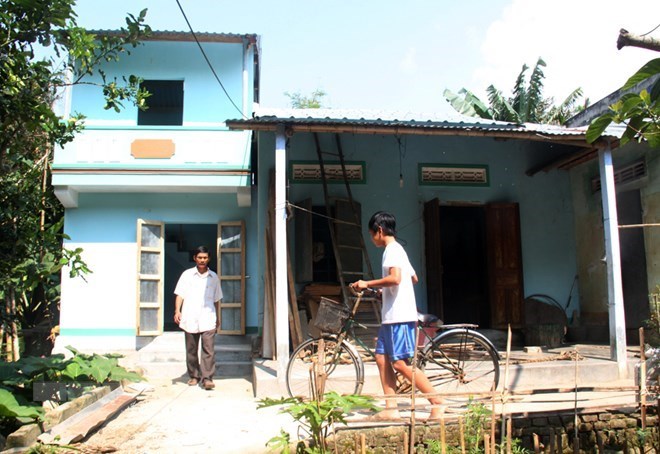
A project to build houses resilient to storms and floods for 782 poor
households in coastal area of the north central province of Thanh Hoa will be
carried out from 2018 to 2022
A project to build houses resilient to storms and
floods for 782 poor households in coastal area of the north central province
of Thanh Hoa will be carried out from 2018 to 2022.
The houses will be built for disadvantaged families in
the province’s four coastal districts of Nga Son, with 170 houses, Hau Loc
(136), Hoang Hoa (210) and Tinh Gia (266), at a cost of more than 4 billion
VND (about 174,800 USD).
The province is among five coastal localities of
Vietnam benefitting from the project funded by the Green Climate Fund (GCF)
through the United Nations Development Programme.
About 200-340 houses will be completed in the first
part of the project in Thanh Hoa, as constructions of some houses began
earlier in June.
GCF Director in Thanh Hoa Le Cong Cuong said the
organisation has worked with local authorities to provide safe and stable
houses for disadvantaged households which are vulnerable to storms and
floods, thus improving their lives and contributing to poverty reduction.
The project will support the construction of 4,000
houses in Thanh Hoa, Quang Binh, Thua Thien-Hue, Quang Nam and Quang Ngai
provinces. It will run until 2022 with non-refundable assistance totalling
about 29.5 million USD.
Major drug trafficking ring busted in Son La
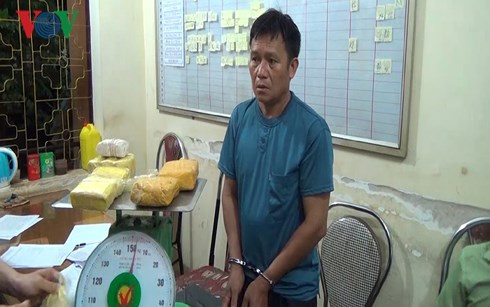
Ly A Chong
Police of Song Ma district in the northern province of
Son La have cracked a major drug trafficking ring, seizing nearly 24,000
pills of synthetic drug and 7kg of opium latex.
Ly A Chong, 54, residing in Song Ma district, Son La
province, was apprehended at 4pm on June 27 while in the process of smuggling
a large volume of synthetic drug and opium latex.
Police also confiscated a motorbike, a mobile phone and
other related evidence.
The suspect confessed to having bought the drugs from
an unknown man and that he intended to profit from the sale and distribution
of the drugs.
Further investigations are underway.
Winners of theory and criticism of literature and arts
awards honoured
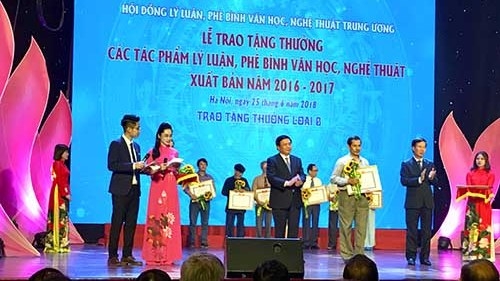
At the awards presentation
ceremony (Photo: hanoimoi.com.vn)
A ceremony was held in Hanoi on June 25 by the Central
Council for the Theory and Criticism of Literature and the Arts to honour the
winners of the Literature and Arts Awards in 2016 and 2017.
The ceremony was attended by Politburo member,
Secretary of the Party Central Committee (PCC) and head of the PCC’s Communication
and Education Commission, Vo Van Thuong; and Secretary of the PCC and
Director of the Ho Chi Minh National Academy of Politics, Nguyen Xuan Thang.
The winners include 28 of the most outstanding works as
voted for by the Council. Ten B, 13 C and five consolation prizes were
presented to artists from local literature and arts associations.
The entries sent to this year’s awards received praise
for being of higher quality than previous years. In addition, many works
covered important issues facing the country.
In addition, nine press agencies and publishing houses
were also praised during the event for their contributionsto popularising
works of literature and art.
Drug users fret over expiry date of Suboxone pilot
program
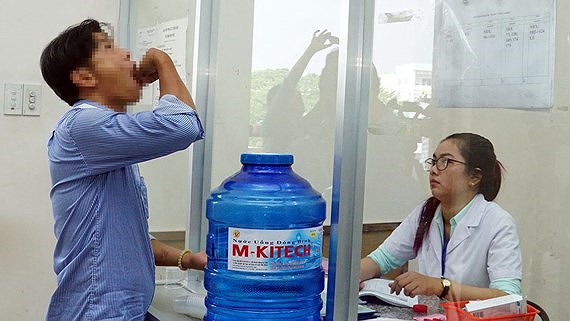
After two-year implementation project of Suboxone for
injecting drug users in the Preventive Medicine center in Go Vap District in
Ho CHi Minh City under the support of the French Governmental Agency ESTHER
and the National Institute on Drug Abuse, many drug addicts succeeded in
undergoing detoxification to start a new life; however, many of them fretted
because of drug shortage and expiry date of the pilot program.
The health sector has to find effective alternative medication when Suboxone in the pilot program runs out of. One of injection drug users successful in detoxificating is Th. in Hoc Mon District who have been addicted to drug for over 13 years. His family found out the information of the pilot program; subsequently, he was taken to the Preventive Medicine center in Go Vap District to take Suboxone as per the program. He said after one-week treatment with Suboxone, he was not addicted to the drug though he spent VND300,000 - 400,000 ($13 -$17.4) buying drug. He got healthier and gained weight. "I start to help my family's business; hence, I feel happier", said Th. Director of the center in Go Vap District Dr. Nguyen Trung Hoa said that 22 drug addicts are treated with Suboxone in the center and 80 percent of them get success. In comparison of buprenorphine and methadone, Suboxone has more advantages. Drug users must take Methadone daily because it has 24-36 hour half life while Suboxone has 48-72 hoour haf life so patients can take daily or alternate day in a week. On the other side, Suboxone has no interaction with Antiretrovirals (ARV) and tuberculosis medication.Accordingly, Suboxone is used to treat drug addiction in many nations in ten past years, said Dr. Nguyen Trung Hoa. The Suboxone -treated pilot program implemented from May, 2015 with 252 patients but 22 of them are being treated this time. Sadly, the pilot program ended in August, 2017 and nearly one year, 22 drug users receive the remaining drug in stock. Scientific journals in international conferences highly spoke of the effectiveness of Suboxone in the Preventive Medicine center in Go Vap District with the aim to propose Vietnamese Ministry of Health buying the drug to treat patients, Dr. Hoa said. People's Committee in Ho Chi Minh City has implemented "The action month against drug", “World Drug Prevention”. This year, a month-long program themed " To protect young generation against drug danger" aimed to increasing information of prevention task and bad effects of drug on young people as well as encourage people to participate in keeping security order in residential quarters.
Campaign on greening vocational education launched in
TVET institutes
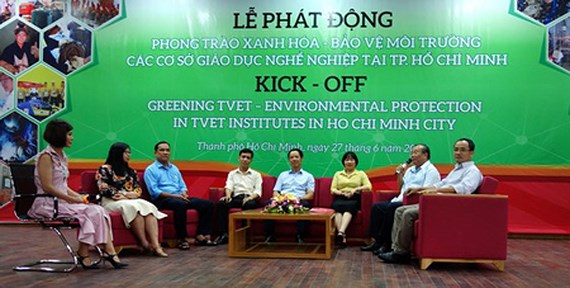
The campaign “Greening TVET – Environmental Protection
in TVET Institutes” which develops skills and provides knowledge to ease
transitions to green economies and societies was kicked off yesterday among
technical and vocational education and training institutes in Ho Chi Minh
City.
The campaign was launched by the Directorate of
Vocational Educationand Training, the Ho Chi Minh City Department of Labor –
Invalids and Social Affairs, the College of Technology II and the German
agency of international development cooperation Deutsche Gesellschaft für
Internationale Zusammenarbeit (GIZ),
According to Doctor Truong Anh Dung, Deputy Director of
the Directorate of Vocational Education and Training, the concept of greening
TVET is quite new in Vietnam, which is aiming at strategies and policies for
the sustainable development in relation with comprehensive greening.
To achieve this goal, the role of education is
critical, especially in training human resources that are able to meet
requirements of greening the economy by effectively using energy and
resources at their workplace, correctly applying environmentally friendly
technologies while preventing potential environmental damages.
Head of the college Ms. Nguyen Thi Hang said that the
green factor is embedded into the curriculum, especially in the major of
‘Technology in draining and sewage treatment’ – a cooperative program between
the college and six businesses of the field. The college campus is undergone
the greening process as well.
Deputy Director of the Ho Chi Minh City (HCMC)
Department of Labor – Invalids and Social Affairs Nguyen Van Lam suggested
that these institutes prepare a detailed plan to gradually introduce the
concept of greening to the staff as well as students.
In July 2018, the department is going to organize a
training workshop for leaders of colleges and vocational schools in the city
about the greening of TVET.
There were more than 50 vocational schools, colleges
and representatives of businesses took part in the event.
Vietnamese artists participate in cultural art exchange
in Norway
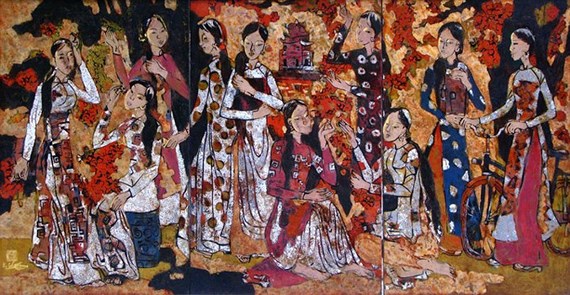
A painting by artist Le
Xuan Chieu
A group of 8 painters of the Ho Chi Minh city Association
of Fine Arts took part in an exhibition in the Kingdom of Norway.
Artists including Le Xuan Chieu, Dang Thi Duong, Ly
Khac Nhu, Hua Thanh Binh, Bui Tien Tuan, Viet Thi Kim Quyen, Nguyen Phan Nam
An and Nguyen Tri Minh Tuyet brought 45 artworks in various materials, such
as lacquer, oil, silk and ceramic to the “Saigon art exhibition” held in
Hedmark county in Eastern Norway.
At an exchange between the two sides, Norwegian artists
are interested in Vietnamese artists’ activities, their trend, role and
position in the modern society as well as materials used for fabric and
lacquer paintings.
The delegation of Vietnamese painters also visited art
museums, landscapes and met Norwegian Vietnamese artist Duc Thanh Hong who is
specialized in painting on ceamic in Norway.
The “Saigon art exhibition” runs until August 25.
Exhibition on trade union activities held in HCMC
An exhibition titled “Proud to be a worker of heroic
city” opened at the Ho Chi Minh City Labor Culture Palace on June 26.
The event introduces to viewers workers’ achievements
in working and production in Ho Chi Minh City and Ton Duc Thang award-winning
products of key industries, including new technological model, high-tech
products, high-tech agricultural products, health and the reform of administrative
procedures.
The exhibition is also to honor the results and
outstanding activities of workers and trade union organizations in the city
in the 2013-2018 period and to mark the 11th Trade Union Congress of the 2018
- 2023 period.
Deputy chairman of the Ho Chi Minh City Labor
Confederation, Tran Doan Trung said that the last term saw significant
achievements in various fields. Workers, civil servants and employees made
initiatives in improving the operation of devices and machines to better working
condition, save production costs, increasing working productivity and product
quality.
My Thuan 2 Bridge needs VND5.2 trillion
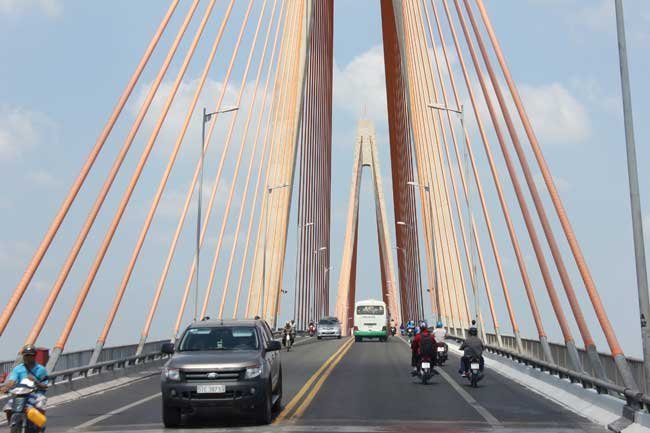
A view of the current My
Thuan Bridge. When in place, My Thuan 2 Bridge will ease traffic on the My
Thuan Bridge
An estimated VND5.2 trillion, or US$227 million, will
be required to build My Thuan 2 Bridge connecting Tien Giang and Vinh Long
provinces.
Project Management Unit 7 (PMU7) under the Ministry of Transport has completed the feasibility study for the project. The bridge and approach roads will have a total length of 6.6 kilometers. Located 350 meters upstream of the existing My Thuan Bridge, My Thuan 2 will start from an intersection with Trung Luong-My Thuan Expressway and end at an intersection with National Highway 80, the starting point of My Thuan-Can Tho Expressway. Besides My Thuan 2, the project will include constructing An Huu, Rach Son, Rach Gong and My Hung 2 bridges. According to the feasibility study, the technical design for the project will be made ready in the second half of the year. The project will get off the ground in the third quarter of next year and construction work is expected to take three years. According to PMU7, as Cao Lanh Bridge was opened to traffic last month and Vam Cong Bridge will be finished soon, vehicle traffic on the operational My Thuan Bridge will surge. Therefore, My Thuan 2 will play a pivotal role in easing the burden of My Thuan when large bridges in the Mekong Delta and Trung Luong-Can Tho expressway are put into use.
Conference seeks NGOs’ financial assistance for Thanh
Hoa

A conference to call for foreign non-governmental
organisations (NGOs)’ financial assistance in poor areas in the central
province of Thanh Hoa took place in Hanoi on June 27.
Speaking at the event, Vice Chairwoman of the
provincial People’s Committee Le Thi Thin said Thanh Hoa lies in a gateway
between the north and central of Vietnam with railway, road, waterway and
aviation infrastructure.
As a poor province with limited internal resources, Thanh
Hoa always heeds external economic activities to attract foreign resources,
focusing on calling for official development assistance and foreign NGOs’
aid, she said, adding that the province now records 84 valid foreign-invested
projects with a total investment of over 13.98 million USD.
The Vietnam Union of Friendship Organisations has also
listed Thanh Hoa among the top localities nationwide that has effectively
used foreign NGOs’ aid.
Over the past decade, the total financial assistance
provided by foreign NGOs has hit 78.96 million USD via more than 300
projects. Up to 7.9 million USD on average was disbursed each year. In the
first half of this year, 3.5 million USD has been disbursed.
The projects are mostly in agriculture, rural
development, poverty reduction, capacity improvement, health care, education,
environment protection, natural disaster mitigation and climate change
response.
Many projects funded by NGOs have been productive and
spread to many localities such as a children-oriented education model by the
World Vision in seven mountainous and disadvantaged districts, the
trans-generation mutual support club by Help Age.
Thinh urged foreign NGOs in Vietnam to assist Thanh
Hoa’s sustainable socio-economic development and pledged all possible support
to their projects.
Phan Anh Son, head of the VUFO’s People’s Aid
Coordinating Committee said in the past five years, VUFO together with
ministries, agencies, localities and partners effectively carried out the
national programme on foreign aid mobilisation for the 2013-2017 period. The
framework programme for 2017-2022 have been devised.
Participants at the event discussed potentials and
strengths of Thanh Hoa, local demand for foreign capital and aid.
On the occasion, the provincial authorities signed
memoranda of understanding with foreign partners and presented decisions
approving projects using NGOs’ aid.
Quang Nam works to alleviate poverty rate among ethnic
minorities

A festival of the Co Tu
ethnic minority in Quang Nam province
The central province of Quang Nam’s efforts to reduce
poverty rate among ethnic minority groups have given a new look to the rural
mountainous areas as local livelihoods have been improved significantly.
Guided by the Prime Minister’s Decision No.1557/QD-TTg dated September 10, 2015 approving a number of targets in realising Millennium Development Goals for ethnic minorities associate with the Sustainable Development Goal after 2015, the province has paid due attention to planning works and building residential areas for residents in mountainous areas to ensure that they have stable accommodation and land for production. Last year, nearly 106 billion VND (4.56 million USD) was arranged to help nearly 1,500 households settle down and branch out production. The mountainous districts have combined forestry development with poverty reduction programmes while encouraging the cultivation of medicinal herbs in line with local policies. During 2016-2017, the National Target Programme for Sustainable Poverty Reduction allocated over 165 billion VND (7.09 million USD) to Quang Nam to support infrastructure and production model development for six poor districts and 19 special difficult communes in coastal and island areas. Particularly, after one year implementing the provincial policy on encouraging districts and communes to try and escape poverty, nearly 4,000 households, including 2,700 families in the mountainous areas, have registered to get out deprived situation sustainably. Last year, average economic growth in the ethnic minority area reached 7.1 percent much higher than the province’s average level of 5.55 percent. Poverty rate in the nine mountainous districts tapers off 5 percent per year. Nearly 92 percent of the ethnic population have been connected to the national electricity grid while the rate of households using hygienic water is over 81 percent. The literacy rate reached nearly 98 percent among ethnic population from 15 years old. In a bid to realise the sustainable poverty reduction goal for ethnic minorities, Quang Nam province plans to prioritise more resources and carry out a set of comprehensive measures like infrastructure development, socio-economic development programme and preferential loans. Quang Nam province is currently home to 32,000 ethnic minority households with nearly 150,000 people, accounting for 10 percent of the province’s population. They reside mostly in six mountainous districts of Nam Tra My, Bac Tra My, Tay Giang, Nam Giang, Dong Giang and Phuoc Son.
Flood victims to receive aids
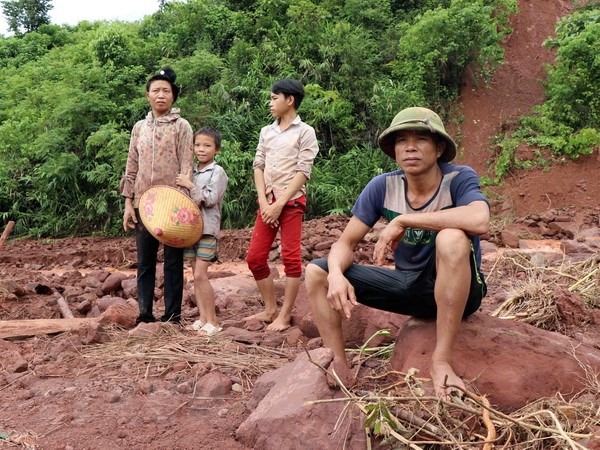
Quàng Văn Ố, a resident of Sìn Hồ district’s Noong Hẻo
commune, has lost his crops and fish ponds to flash floods.
Government agencies and donors have joined hands to
provide urgent assistance to people who have been affected by floods in the
past several days.
The Việt Nam Fatherland Front Central Committee (VFFCC)
had an urgent meeting on Wednesday to discuss measures to help the
flood-affected people.
At the meeting, VFFCC president Trần Thanh Mẫn assigned
Hầu A. Lềnh, VFFCC vice president and head of the Centre Rescue Committee, to
directly inspect the flood-relief work.
The VFFCC is leading the way to deliver aid worth VNĐ1
billion (US$43,000) to the two hard-hit provinces of Lai Châu and Hà Giang.
So far, the VFFCC has sent aid worth VNĐ5 million
($215) to each family whose member is either dead or missing in the floods
and VNĐ3 million ($129) to each family with an injured member. It has also
contributed VNĐ50 million ($2,150) to build new houses for those whose homes
have been swept away in the floods.
With an aid movement underway across Việt Nam, Mẫn has
asked the VFF in the northern mountainous provinces to provide frequent
updates about the flood situation so that the Central Rescue Committee can
offer proper and timely support to the needy.
He said flood-hit localities should report about
donations and aids from organisations and individuals to the VFF as this
would help minimise the overlapping of aid in the same area and prevent
shortage of aid in other areas leading to insecurity and disunity in the
community.
Mẫn also asked VFF in localities to re-examine the
total aid under their management and report to VFFCC. Based on this, VFFCC
will re-arrange and allocate aid to localities in need.
The Ministry of Agriculture and Rural Development on
Thursday provided aid to flood-affected people in northern Lai Châu Province.
Each family of a flood victim will receive VNĐ3-5 million ($129-215).
Minister of Agriculture and Rural Development Nguyễn
Xuân Cường has called on cadres and staff to contribute at least one day’s
salary to help flood victims. The aid will be immediately transferred to
people in the affected areas.
Meanwhile, the Governor of State Bank of Việt Nam
(SBV), Lê Minh Hưng, on Wednesday requested SBV branches in Hà Giang, Lai
Châu, Thái Nguyên, Điện Biên, Tuyên Quang, Lào Cai and Cao Bằng provinces to
support the flood-affected people.
The SBV branches have also been asked to apply
supportive measures, such as extending repayment deadlines and interest rate
exemption and reduction for flood-affected customers.
The SBV has so far raised VNĐ2.3 billion ($98,900) for
flood victims.
Nguyễn Khắc Chử, secretary of the Provincial Party
Committee in Lai Châu, on Thursday, donated VNĐ30 million ($1,290) and daily
necessities to 28 families whose houses and properties were buried due to
erosion in Tả Ngảo commune on Wednesday. Traffic is still blocked in the
commune.
In northern Điện Biên Province’s Mường Nhé District,
rescue teams have managed to supply food, clothes and provide shelter to
affected people.
According to the latest report of the Central Steering
Committee on Natural Disaster Prevention and Control, flash floods have
killed 23 people and left 11 missing in northern mountainous provinces,
mostly in Hà Giang, Lai Châu, Lào Cai and Điện Biên.
Torrential rains and floods have also swept away 161
houses, damaged 958 houses and submerged thousands of hectares of crops.
Roads and irrigation works too have been damaged,
causing losses of VNĐ487 billion ($20.9 million).
PVF start strong at national U17 champs
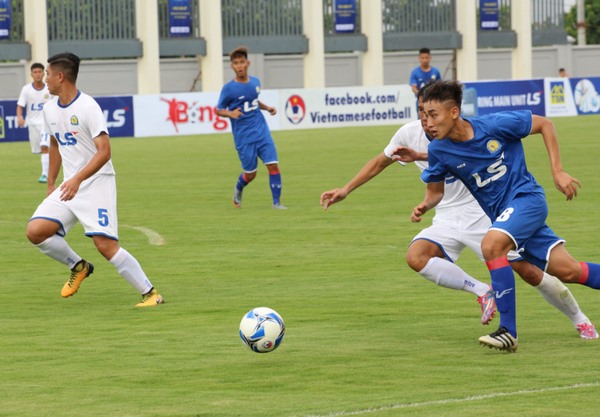
Defending champions PVF
took on Bình Dương at the National U17 Football Championship’s final round on
on June 27. — Photo thethaovietnam.vn
Defending champions PVF had a good start in the final
round of the National U17 Football Championship with a 3-0 win over Bình
Dương.
The game, which was held on Wednesday at the Promotion
Fund for Vietnamese Football Talent Centre (PVF) in the northern province of
Hưng Yên, was PVF’s first match in Group A.
PVF banked on home support to control the game from the
opening minute, with Nguyên Hoàng scoring two goals in the first half.
After the break, Bình Dương tried to fight back but
failed to score any goals.
Hoàng completed a hattrick for the hosts in extra time.
The tournament features eight teams which qualified for
the final round from the initial 24 teams. They will play in a round-robin
format in the group stage, and the four best teams will advance to the
semi-finals.
The two winners of the semi-final games will play in
the final to determine who wins the championship. The two teams that lose in
the semi-finals will be awarded joint third prize.
VNN
|
|
BUSINESS IN BRIEF 29/6
SaigonBank, CEP sign financial service deal to benefit
workers
The Saigon Bank for Industry and Trade (SaigonBank) and Capital Aid for Employment of the Poor Microfinance Institution (CEP) on June 27 clinched a comprehensive cooperation agreement to provide financial services for workers. Vu Quang Lam, acting chairman of the Board of Directors at SaigonBank, said at the signing ceremony that the deal is aimed at making the provision of financial services for workers, who are also CEP’s clients, convenient and cost-effective. SaigonBank will implement a series of incentive policies for CEP’s customers, such as offering them bank cards with the lowest annual fees on the market, a CEP loan disbursement fee exemption, and a cash withdrawal fee exemption at its ATM machines. CEP general director Nguyen Thi Hoang Van said the partnership between SaigonBank and CEP would better serve CEP customers. CEP is a non-profit Vietnamese microfinance institution that is active in provinces in southeastern Vietnam and the Mekong Delta. The mission of CEP is to help improve the living conditions of the poor and the poorest through the efficient, effective and sustainable provision of microfinance services.
Global protection sought for Vietnam’s rice trademark
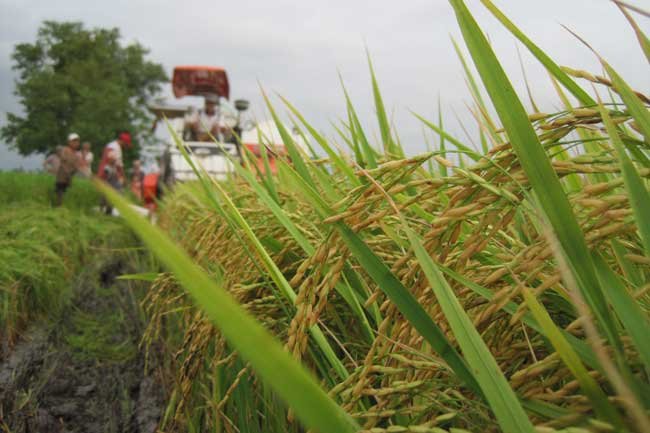 As Vietnam’s rice trademark is undergoing procedures to seek international protection, the result of the logo design contest will not be announced until next month, an official of the Ministry of Agriculture and Rural Development said. Le Thanh Tung, head of the southern representative office of the ministry’s Department of Crop Production, told The Saigon Times that the contest winner has been chosen. According to Tung, to have the rice trademark protected, Vietnam has filed an application with the Madrid System, a system for the registration of trademarks worldwide governed by the Madrid Agreement and the Protocol relating to the agreement. A single application with the system enables a trademark owner to obtain protection in member countries. The ministry has formulated regulations concerning the use of the Vietnamese rice trademark, requiring individuals and organizations to meet particular requirements to use the trademark, Tung stated. In particular, as Decision 1499/QD-BNN-CBTTNS issued this year stipulates, individuals and organizations can use the registered trademark when granted business registration certificates or investment certificates that include rice production, processing and trading. Individuals and organizations must be certified to satisfy food-safety requirements for rice processing, preservation and trading, or they must obtain one of the following certificates: good manufacturing practice, hazard analysis and critical control points, food safety management system ISO 22000, international food standards, global standard for food safety, food safety system FSSC 22000 or equivalents that are still valid. They must have rice products certified to meet Vietnamese standards, fulfill tax obligations and work to protect the environment. Rice products that have been certified include white rice, jasmine white rice and glutinous white rice. Regarding product quality, rice bearing the Vietnamese rice trademark must comply with national quality standards, with white rice meeting TCVN 11888:2017 requirements, jasmine white rice meeting TCVN 11889:2017 requirements and glutinous white rice meeting TCVN 8368:2010 requirements. If there is a change to quality standards, rice products must meet the updated standards. Under Decision 1499 of the ministry, individuals and organizations can use the rice trademark and their own brands for packaging, advertising and trading certified rice products. They can also exploit, use and enjoy other economic benefits that arise, and participate in rice trademark promotion activities. However, individuals and organizations are obliged to use the trademark only on certified rice products, to ensure product quality, to inform the trademark management unit if they no longer need to use the trademark, and to pay any related fees.
SaigonBank, CEP sign financial service deal to benefit
workers
The Saigon Bank for Industry and Trade (SaigonBank) and Capital Aid for Employment of the Poor Microfinance Institution (CEP) on June 27 clinched a comprehensive cooperation agreement to provide financial services for workers. Vu Quang Lam, acting chairman of the Board of Directors at SaigonBank, said at the signing ceremony that the deal is aimed at making the provision of financial services for workers, who are also CEP’s clients, convenient and cost-effective. SaigonBank will implement a series of incentive policies for CEP’s customers, such as offering them bank cards with the lowest annual fees on the market, a CEP loan disbursement fee exemption, and a cash withdrawal fee exemption at its ATM machines. CEP general director Nguyen Thi Hoang Van said the partnership between SaigonBank and CEP would better serve CEP customers. CEP is a non-profit Vietnamese microfinance institution that is active in provinces in southeastern Vietnam and the Mekong Delta. The mission of CEP is to help improve the living conditions of the poor and the poorest through the efficient, effective and sustainable provision of microfinance services.
Food safety remains major concern at wholesale markets
Controls for food safety and the traceability of products sold
in wholesale markets is not tight enough, as market management boards have
yet to fulfill their duties, heard a seminar on the development of wholesale
markets in Vietnam, held in Hanoi on June 27.
As of last year, Vietnam had only 83 wholesale markets, making up nearly 1% of the 8,500 traditional markets in the country. However, the trading practice has largely been limited to traditional methods, with traders paying little attention to quality control. Dao Ha Chung, chairman of the HCMC Hi-Tech Association, was cited by news website Vietnamplus as saying that the relevant agencies find it hard to manage goods traded in wholesale markets. He proposed enhancing controls over vehicles transporting goods to these markets to ensure food safety. In addition, wholesale markets should make prices transparent, regularly assess the quality of products, take steps to reduce waste and invest in traceability systems, he added. Ricardo Lopez Pietsch, a representative of Spain’s Mercasa Group, which manages 23 wholesale markets in Spain, shared his experience, noting that wholesale markets should help farmers understand consumers’ demands to produce standard goods. Markets in Spain also have warehouses, cold storage facilities and dedicated areas for support services. Inspectors are present at markets to make sure that products meet prevailing food safety requirements, Ricardo stated. Vu Duy Dong, director of the Domestic Market Department under the Ministry of Industry and Trade, emphasized the management of wholesale markets, adding that it is necessary to ensure food safety in wholesale markets and to provide traders with essential knowledge. Nguyen Van Hoi, deputy director of the department, noted capital as a major obstacle hindering the development of wholesale markets, claiming that investment in these markets is high, at VND40 billion each on average, while the State budget is limited, and it is hard to tap private resources. In addition, most foreign firms want to develop modern trade facilities in large cities rather than traditional markets. The lack of incentives to support investors and the small space for goods storage, parking lots and internal roads in wholesale markets have also hindered the development of these markets. Moreover, trade support services such as banking, insurance, product quality evaluation, classification, packaging, preservation, consulting, market information provision, advertising and accounting have not been provided at wholesale markets.
Land ownership should be assigned to households,
individuals: VFCEA
Although the land law has undergone multiple revisions, it still contains inadequate regulations, so the Vietnam Federation of Civil Engineering Associations (VFCEA) has recommended handing over land ownership to households and individuals. Early this year, the Ministry of Justice was told to seek comments and amend inadequate, overlapping regulations concerning access to land by people and enterprises for their production and business investments. The Ministry of Justice and the Vietnam Chamber of Commerce and Industry on June 27 held a seminar on land access by people and enterprises to collect comments in preparation for amending the law, even though it was revised only five years ago. Tran Ngoc Hung, chairman of the VFCEA, proposed amending the law in a way that gives land ownership rights to households and individuals. This, Hung said, will directly affect millions of households and help avoid problems arising from land disputes, compensation and clearance. Lawyer Truong Thanh Duc noted that the problem lies in the ownership of assets. In reality, people can buy and transfer assets, which is a way of exercising their rights, but the transfer of land use rights, as it is currently worded in the law, does not make sense. Similarly, the mortgage of land use rights is by nature a land mortgage, and it is impossible to separate the two. According to Hung, if such points are not amended, inadequacies will remain. For instance, there is a regulation that allows the State to recall land in case of necessity for national defense, security and socioeconomic development purposes. However, the cases of necessity are not clear, especially when it comes to the construction of industrial parks, economic zones, export processing zones, new urban areas, offices of State agencies and relics. According to Hung, the construction of offices of State agencies, relics, scenic spots, squares and statues are not really necessary, and some interest groups tend to take advantage of gray areas to establish projects that benefit them, particularly urban area projects with land recalls.
Startups should map out plans to go global: experts
Domestic startups should promptly draw up detailed action plans to expand to international markets, consulting experts advised at a forum titled, “Connecting Vietnamese startups at home and abroad,” in HCMC. During the project presentation of startups within the framework of the forum held on June 27, experts said Vietnamese startups should make careful preparations to seek capital and attract investors. Local startups are currently mainly developing products and seeking local customers. Meanwhile, the connection of startups with finance and intellectual property experts across the world remains modest. Only startups that have received foreign investments have opportunities to access finance and corporate administration consulting experts and companies. Startups should prepare information on their rivals, the market scale and their objectives before calling for investments. Shlomo Nimrodi, CEO of the Ramot Business Engagement Center at Tel Aviv University in Israel, commented on the Ekid Studio project, which was presented at the forum, noting that the project developer should focus on its specific tasks, such as teaching language by applying technology. However, Patrick Nguyen, founder of Ekid Studio, explained that his company does not operate as a language teaching facility. Instead, it will specialize in augmented reality in the education sector. In reality, some startups have high-quality products and services that meet the demands of customers in some cities such as HCMC and Hanoi. However, they have encountered multiple obstacles in expanding to other markets. At the forum, Thach Le Anh, cofounder of Vietnam Silicon Valley Accelerator, agreed that some startups cannot seek capital despite the good quality of their products, while the number of venture funds in Vietnam is modest. In 2016, investment in domestic startups totaled US$100 million, well below the US$1.5 billion poured into startups in other Southeast Asian countries.
Vietnam’s tourism brought closer to Czech people
Vietnam’s popular tourist attractions and unique traditional arts were spotlighted at a tourism promotion programme held in Prague, the Czech Republic on June 27. The event was organised by the Vietnam National Administration of Tourism (VNAT) in collaboration with the Vietnamese Embassy in the Czech Republic, the national flag carrier Vietnam Airlines, and Vietnamese travel firms in the host nation. This is the final stop of the Vietnam Tourism Roadshow Europe 2018 which has travelled through Sweden, Austria and Hungary. Highlighting the traditional friendship between Vietnam and the central European country, VNAT General Director Nguyen Khac Tuan stressed that both sides pose huge potential for tourism cooperation. Vietnam welcomed only 1 million foreign visitors in 1995 but the figure is forecast at 16 million this year, including 2 million European holiday-makers, Tuan said, adding that however, only 17,000 of them come from the Czech Republic. This is a modest figure when Vietnam’s tourism has many things appealing to Czech visitors like beautiful beaches along its 3,000km of coastline, a stunning Ha Long Bay, gigantic Phong Nha-Ke Bang Cave, and unique orchard gardens in the south, he noted. On the sidelines of the event there were meetings between Vietnamese and Czech tourism agencies, which served as a bridge for them to seek cooperative opportunities. VNAT General Director Tuan and deputy chairman of the Association of Czech Travel Agents Jan Papez told Vietnam News Agency’s reporters that Vietnamese and Czech tourism products all satisfy demands of tourists from both countries. However, they said that visa procedures, the absence of direct flights between Hanoi or Ho Chi Minh City and Prague as well as weak promotion campaigns are the main barriers for bilateral cooperation.
Manufacturing firms perform better in Q2
Up to 82.6 percent of the processing and manufacturing
enterprises said they enjoyed a more stable and better business operation in
the second quarter of the year, according to the General Statistics Office of
Vietnam.
The foreign direct investment firms have the highest
business confidence with 85.7 percent believing that their business improved
and stabilised during April-June. Meanwhile, the percentage for state-owned
and private companies was 80.8 percent and 81.6 percent, respectively.
In stark contrast, 17.4 percent of the firms said that
they had to struggle more than the previous quarter.
Competitiveness was touted as the dominant factor that
left enormous impacts on production and business activities. According to the
statistics office, 59.4 percent of the firms said that they were affected by
competitive edge while 46.2 percent believed that underperformed business was
spurred by low demands in the domestic market.
Financial issue, shortage of qualified labourers, high
deposit rate, lack of materials, and out-of-date technology and equipment
were the other factors challenging local businesses in the period.
Regarding volume of orders, 82.8 percent of the firms
reckoned that the number would be higher than the previous quarter while 17.2
percent said that they would face less orders than the previous quarter. Up
to 84.8 percent of the enterprises affirmed that they had more orders from
overseas market.
Product inventory was reported to decrease or remain
stable among 81.7 percent of the domestic companies.
However, the statistics department said that businesses
have more positive outlook for their business prospects in Quarter 3 with
88.5 percent of the firms upbeat about their performance.
The statistics were compiled based on the latest survey
on the quarterly business performance trend of 6,500 industrial processing
and manufacturing companies in 63 provinces and State-run cities.
Programme promotes Vietnamese localities in France
The Vietnam Provincial Roadshow in France took place in
Paris from June 25-27, as part of activities to mark the 45th anniversary of
bilateral diplomatic ties and five years of the Vietnam-France strategic
partnership.
The event, jointly held by Vietnam’s Ministry of
Foreign Affairs, Embassy in France and the Permanent Delegation of Vietnam to
UNESCO, attracted the participation of officials of Hanoi, the Mekong Delta
city of Can Tho, and central Phu Yen and Quang Ngai provinces, ministries,
sectors and businesses of involved localities.
Vietnamese Ambassador to France and Head of the Vietnam
Permanent Delegation to UNESCO Ambassador Tran Thi Hoang Mai also joined
activities of the Vietnamese delegation.
Within the framework of the programme, the delegation
held working session with Deputy Chief Executive Officer of the French
Development Agency (AFD) Philippe Bauduin, President of the Regional Council
of Ile-de-France Valérie Pécresse, and Director General of the union of
French cities (Cites Unies France – CUF) Geneviève Sevrin.
They attended a workshop on intensifying
Vietnamese-French locality partnership, and another on regional planning and
construction experience of Paris capital, met with representatives from
French localities such as Ile-de-France, Bordeaux, Val-de-Marne, Poitiers and
Cergy-Pontoise and major businesses including Vinci, Dassault Systemes,
Pollutec, Seche Environnement, and JCDecaux, and visited several health
clinics and waste treatment facilities in Paris.
During these events, both sides spoke highly of
positive development in the bilateral strategic partnership, in which
cooperation at the local level and people-to-people exchange are an important
cooperation pillar that need to be enhanced.
At present, 38 French localities have set up
cooperative ties with 18 Vietnamese provinces and cities.
The two sides agreed to coordinate in organising the
11th Vietnamese-French locality cooperation conference in France’s Toulouse
city in April 2019, maintain successful cooperative models such as Hanoi –
Ile-de-France, Hanoi – Toulouse, Hai Phong – Brest, Lao Cai – Aquitaine, Hue
– Aquitaine, Yen Bai – Val de Marne, Can Tho – La Seyne-sur-Mer, and
encourage the establishment of new pairs of localities.
Along with such traditional cooperative fields as
health, education, water-environment, heritage preservation and sustainable
rural development, it is necessary to expand collaboration to new areas like
smart city building and digital economy, they said.
The French side committed to maintaining ODA provision
for Vietnam, while appreciating the role of Vietnamese localities in
successfully carrying out France’s ODA projects in Vietnam.
On this occasion, Chairman of the Hanoi People’s
Committee Nguyen Duc Chung and President of the Regional Council of
Ile-de-France Valérie Pécresse signed an action programme of the two
localities for 2018-2021.
The Vietnam Provincial Roadshow is an effort by the
Foreign Ministry to coordinate with Vietnam’s representative offices abroad
in helping Vietnamese localities tighten their cooperation with foreign
partners.
Dong Nai enjoys over-1-billion USD trade surplus in H1
The southern province of Dong Nai enjoyed a trade surplus of over 1 billion USD in the first six months of 2018. According to the provincial People’s Committee, the total export turnover of businesses in the locality exceeded 9 billion USD in the reviewed period, while the import value was 7.95 billion USD, year-on-year rises of 12.6 percent and 7.12 percent, respectively. The province’s main exports recorded significant growth, including footwear (7.19 percent), garment and textiles (4.49 percent), textile fibre (17.7 percent), machinery and components (15.05 percent), iron and steel products (21.6 percent), and computer, electronic products and spare parts (37.8 percent). The committee said that the growth was attributed to stable world economy, favourable export markets, more orders from abroad, and increases in export prices of several commodities. Dong Nai’s main export markets were the US, the European Union, the Republic of Korea, China and Japan. Meanwhile, businesses in the province mainly imported products from China, the Republic of Korea, and Taiwan (China), which accounted for 50 percent of its import turnover. The locality mainly imported fabric, fibre, footwear materials, chemicals, iron and steel. To achieve the target of 18.3 billion USD in export turnover this year, the province will intensify assistance for businesses, especially small- and medium-sized enterprises and startups, and build a mechanism to encourage businesses to invest in rural agriculture. More efforts will be taken to improve the investment environment, speed up administrative reform, and create favourable conditions to promote products and trademark and raise export value, particularly for agricultural products.
SaigonBank, CEP sign financial service deal to benefit
workers
The Saigon Bank for Industry and Trade (SaigonBank) and Capital Aid for Employment of the Poor Microfinance Institution (CEP) on June 27 clinched a comprehensive cooperation agreement to provide financial services for workers. Vu Quang Lam, acting chairman of the Board of Directors at SaigonBank, said at the signing ceremony that the deal is aimed at making the provision of financial services for workers, who are also CEP’s clients, convenient and cost-effective. SaigonBank will implement a series of incentive policies for CEP’s customers, such as offering them bank cards with the lowest annual fees on the market, a CEP loan disbursement fee exemption, and a cash withdrawal fee exemption at its ATM machines. CEP general director Nguyen Thi Hoang Van said the partnership between SaigonBank and CEP would better serve CEP customers. CEP is a non-profit Vietnamese microfinance institution that is active in provinces in southeastern Vietnam and the Mekong Delta. The mission of CEP is to help improve the living conditions of the poor and the poorest through the efficient, effective and sustainable provision of microfinance services.
RMIT co-hosts conference on Connectivity in Asia
RMIT University Vietnam, in collaboration with Zhejiang University in China and Inha University in South Korea, co-hosted the “Connectivity in Asia: Trade, Transport, Logistics and Business” conference on June 25 and 26 at the university’s Saigon South campus. The conference was attended by more than 100 keynote speakers, presenters, and delegates from countries including Indonesia, China, the Philippines, South Korea, Thailand, Taiwan, Japan, Malaysia, Singapore, Sri Lanka, Austria, and Australia. RMIT Vietnam President Professor Gael McDonald said RMIT Vietnam was extremely happy to host the event. “The forum was organized to explicitly explore the views of industry experts, policymakers, and academics on the issues surrounding the region’s logistical challenges,” Professor McDonald said. The conference covered topics that play a vital role in Vietnam’s economy, as the country’s growth is fuelled by greater regional and international integration and collaboration, Professor McDonald added. “According to a World Bank estimate, Vietnam’s logistics costs currently account for 20.9 per cent of GDP, compared to China’s 19 per cent, Thailand’s 18 per cent, Japan’s 11 per cent, and the EU’s 10 per cent.” “At a recent national logistics forum, Prime Minister Nguyen Xuan Phuc stated that high logistics costs were one of the hurdles obstructing the national economy’s competitiveness in a highly-connected and integrated trade environment. He emphasized that efforts to lower logistics costs need attention, particularly as Vietnam increases its participation in major free trade agreements.” Professor McDonald stressed that cutting logistics costs to 16-20 per cent of GDP by 2025 while raising its GDP contribution to 8-10 per cent requires additional effort to reform and simplify administrative procedures to improve the business climate. “There were 63 papers presented by contributors from at least 13 different countries, as well as many other participants,” she said of the conference. “Together they explore the current challenges in logistics and hopefully provide a more enlightened road ahead.”
Startup forum connects domestic and international
businesses
More than 400 local and international delegates took
part in the Forum ‘Connecting Vietnamese Startups at Home and Abroad’ on June
26, co-held by the Ministry of Foreign Affairs and the Ho Chi Minh City
(HCMC) People’s Committee.
According to Doctor Nguyen Ky Phung, Deputy Director of
the HCMC Department of Science and Technology, within two years from 2016,
the city spent around $90 million for startup activities, including over $45
million for technology development.|
At the moment, HCMC has more than 350,000 enterprises,
averagely contributing 22 percent to the gross domestic products (GDP),
one-third of the industrial output, one-third of the total income of the
national budget, and one-fourth of the total national exports.
Regarding the gross regional domestic products (GRDP),
the service, industry & construction, and agriculture sectors account for
58.26 percent, 24.78 percent, and 0.81 percent, respectively.
As to the scientific and technological potential, HCMC
now owns a high-tech park, a high-tech agricultural area, the Quang Trung
Software City, the Biotechnology Center, the Institute for Computational
Science & Technology, 45 universities, 30 colleges, over 125
laboratories, and 270 scientific and technological organizations.
Compared to the whole nation, the scientific and technological
resources of HCMC make up 25 percent, the existing businesses, startups, and
scientific & technological enterprises account for 50 percent, 42
percent, and 15 percent respectively.
There are over 760 private groups / startup
organizations in various fields, making up more than 42 percent of the total
number of national startups, 46 percent of which are now taking part in
supportive programs in the city.
222 startups (accounting for 63 percent) have been in
the incubation stage at 10 state incubator centers since 2011, while 49
percent of startups have successfully found their financial sponsor, and 70
percent are entering the first stage of the seed-funding, series A.
According to politburo member and Secretary of the
municipal Party Committee Nguyen Thien Nhan, although HCMC has a number of
advantages, ranging from natural conditions to human resources, its weakness
lies in the administrative role of the government, the implementation of
science and technology into real life, and the connection between businesses
and scientists, all of which have existed for 40 years.
He therefore, put forward two suggestions. Firstly, the
development of the scientific and technological market should be enhanced,
creating a healthy habit of businesses seeking scientists’ help and
strengthening their relationship to exist in harmony.
Another recommendation is that from the beginning,
enterprises should strive to embed technology into their business operations.
Meanwhile, technology people should learn about economic aspect to know how
to identify the needs of the market and seek financial investment
effectively. This would form an advantage for the development of any
enterprise.
Mr. Nhan shared his concerns over essential actions to
help innovative startups, saying that startup activities or ideas do not
necessarily belong to the wealthy ones only. Many Asian countries having a
similar status like Vietnam, yet they are able to achieve impressive success
thanks to their full preparation on technology and an effective financial
connection.
“There are many state programs for this”, he told the
forum, “but only when scientists and entrepreneurs themselves consider such
programs as their own to try their best can they enjoy success.”
Mr. Nhan also expressed his wish to have more forums
like this in the future so that new Vietnamese startup people have an
opportunity to contact with successful ones.
The forum also welcomed Permanent Vice Chairman of the
HCMC People’s Committee Le Thanh Liem, many domestic and abroad speakers as well
as businesses, and leaders of related ministries and departments in the
country.
Vinh Hoan's sales of value-added products to hit $20 bn
by 2020
The Vinh Hoan Corporation has announced that an
increase in sales of value-added products will contribute positively to its
profit margin improvement strategy in the medium and long terms.
In its annual report for 2017, Vietnam’s largest
pangasius exporter announced that the total export value of value-added
products reached nearly $8 million, increasing 2.4-fold against 2016, and
that its share in total export value also rose to 3.5 per cent.
In its development orientation, sales of value-added
products are expected to stand at $20 billion by 2020, contributing around 10
per cent of total revenue.
2018 is expected to be another challenging year in
terms of raw material supply due to a shortage of fingerlings and the impact
of high demand in China.
In order to protect its profit target, Vinh Hoan is
implementing a sales strategy with a pricing level that is sufficient to
offset any increase in raw material costs.
The company expects positive results this year from its
collagen and gelatin business after three years of market development. Vinh
Hoan began producing and selling its collagen and gelatin lines in 2015, made
using high-technology and maximizing the value of pangasius skin.
Its Board of Directors (BoD) have evaluated the project
as a success thanks to high technology, a good business model, and the
efforts put into researching production and market development over the last
two years.
With 2017 revenue at VND157 billion ($6.8 million) and
Vinh Hoan collagen making a profit in late 2017, the BoD believes the product
line’s revenue will be no less than VND40 billion ($1.74 million) in 2018 and
will grow faster in subsequent years.
The company also aims to continue expanding its farming
and production capacity, ensuring a high quality supply of raw materials,
competitive production costs, and premium pangasius products that meet the
standards of international certification bodies and the ever-increasing
requirements of export markets.
Vinh Hoan is now focusing on the construction of new
farms and the expansion of processing capacity at its Thanh Binh factory. In
early 2017, the company acquired a 100 per cent stake in the Thanh Binh Dong
Thap Seafood JSC and began operations at the new catfish fillet processing
factory, with capacity of 100 tons of raw materials each day. This was a
strategic move to ramp up production capacity.
The investment plan to increase capacity at the Thanh
Binh factory to 150 tons of raw materials a day is expected to cost
approximately VND100 billion ($4.37 million).
A 220-ha farm in the Mekong Delta’s Long An province
was opened in April and includes a hatchery that will provide sufficient
fingerlings for fish farms. This, together with the application of
innovations to processes and machinery, are expected to increase Vinh Hoan’s self-supply
ratio by a further 40 per cent.
Total investment for the farm is planned at VND220
billion ($9.6 million). There are also other small investments, including
upgrading the collagen workshop, costing VND20 billion ($874,475), and
upgrading and purchasing machinery and equipment for Vinh Hoan’s fish
processing workshop, costing VND35 billion ($1.5 million).
Its anti-dumping tax rate of 0 per cent in the US was
maintained during the 12th and 13th administrative reviews. Along with the
development of new markets, the company continued to use its existing
competitive edge in the US, contributing to higher revenue and profit
margins.
Despite the scarcity of raw materials, the company
managed to open two new markets - Nicaragua and the Czech Republic - contributing
to a network of more than 350 customers in nearly 40 countries. Growth in
market share has also been seen in strategic markets outside of the US,
including 70 per cent in China, accounting for 10 per cent of total exports,
while in Japan it has almost doubled and accounts for 2 per cent.
Vietnamese solar project wins international award
SolarBK's Solar Experience Space project picks up award in Intersolar 2018's "Outstanding Project Award" category. The IREX Energy JSC, a member of Vietnam’s SolarBK Holdings, last week attended Intersolar 2018, an international renewable energy exhibition. This is the fourth time IREX has presented “Made in Vietnam” renewable energy to the world as a “Tier 0” manufacturer. SolarBK’s Solar Experience Space (SES) project won an international award in Intersolar 2018’s “Outstanding Project Award” category. Intersolar is one of the leading events promoting renewable energy and is held annually, with the presence of many prestigious companies from around the world. Intersolar 2018 had more than 900 world renewable energy suppliers, with over 1200 participants from 150 countries around the world. The exhibition took place in Munich, Germany. Prior to that, IREX participated in the largest SPI (Solar Power International) exhibition in 2017 along with Intersolar for three years (2014, 2015 and 2016). It is the first Vietnamese renewable energy enterprise to reach the global market. At the exhibition, IREX took “Made in Vietnam” solar cells and PV panels with the spirit of “Tier 0”. Intersolar 2018 is also an important milestone for IREX on its journey to its Tier 1 target in 2020. Tier, a well-known ranking scale for trustworthy solar panel manufacturers, is issued and rated by Bloomberg New Energy Finance (BNEF) with three levels: Tier 1, 2, and 3. Tier 1 module manufacturers are those that have provided their own brand and own manufactured products to six different projects financed non-recourse by six different non-development banks in the past two years. These 1.5 MW+ deals must be tracked by a database, and the project location (sufficient to identify the project uniquely), capacity, developer, bank and module maker must be in the public domain. Based upon this criterion, only 2 per cent of renewable energy firms have achieved Tier 1, yet those have had such enormous impact on almost the entire market. Up until the third quarter 2017, only 33 firms were rated Tier 1 by BNEF. Unlike many firms in the world, IREX attends Intersolar 2018 as “Tier 0” - its own principle and one that has greatly contributed to helping IREX increase its sales to reputable partners. Many customers misunderstand Tier 1 as a product quality warranty, while it only rates commercial aspects. In fact, quality is measured by international certifications such as TUV and UL, which BNEF itself clearly indicates in reports relating to the issue. The principle of “Tier 0” is based on trust between people with the same mission and development goals. IREX is committed to meeting the product and service quality required by partners at a more competitive price than Tier 1 enterprises. In return, they have put their trust into IREX in the renewable energy community and expanded the circle of cooperation as much as possible. IREX has taken this principle seriously at Intersolar and gained credibility from international partners.
TBS opens sole technology center and R&D center
Shoe sole manufacturer expands production site in Binh Duong province in bid to tackle low localization rate in domestic footwear industry. The TBS Group officially opened the TBS Sole Technology Center and the R&D Center for Sole Manufacturing on May 11 at the Song Than 3 Industrial Zone in southern Binh Duong province. The two centers will focus on researching, developing, and supplying soles for TBS’s shoe manufacturing as well as researching and supplying compound materials for the sole manufacturing industry in general, from combining many raw materials to manufacturing semi-finished products used for compressed soles or EVA phylon. There is potential in Vietnam’s sole manufacturing industry, though most is currently produced by foreign enterprises. Despite Vietnam being in the Top 3 biggest manufacturers of footwear and second in terms of exports, value added remains modest as the localization rate for raw materials and auxiliary materials is only some 50 per cent. Many materials require high technology, including soles, which remains an issue, according to the Ministry of Industry and Trade. With an attitude that “If the world can do it, we can certainly do it,” Mr. Nguyen Duc Thuan, Chairman of the TBS Group, has set a target of mastering technology in the fashion industry. Focusing on the development of shoe sole technology is therefore a great strategy for TBS to fully master technology in the footwear industry. According to figures from the Vietnam Leather and Footwear Association, a pair of soles represents 15-25 per cent of the value of sports shoes, depending on the type of technology used, confirming just how important technology is in creating added value. With a sole factory built in 2002, TBS has mastered the technology of producing rubber soles and EVA phylon. With the addition of the two new centers, TBS will focus on the research, development and supply of a new line of sports shoes with IP Technology (Injection Phylon - technology injecting materials directly into the mold) and new compound materials for soles, to meet demand and stay abreast of development trends in the domestic and foreign footwear industries, especially in regard to soles for sports shoes. On a total area of 113,890 sq m and with advanced equipment and technology, the TBS Sole Technology Center is capable of supplying 32 million pairs of finished products, including EVA phylon, liner, cup insoles, and IP products, and about 20 million products from other materials, including compounds, which will contribute some 20 per cent of the TBS Group’s sales. In order to meet goals, being equipped with advanced technology and equipment is not enough. Over a period of many years, the TBS Group has built up a team of technicians who are knowledgeable about sole production technology but who are nonetheless few in number compared to the huge demand for the production of about 700 million pairs of sport shoes each year in Vietnam. This is a very specific industry where most foreign-owned factories, including joint ventures, do not intend to transfer technology to local factories. The team of technicians is sent by the TBS Group to provide training and attend many international programs on shoe sole technology. Though open since 2002, the first TBS sole factory in 2002 is still relatively young compared to major large corporations such as Pou Chen and Taekwang, Hwasueng, and Feng Hand, which have been in the business for more than 50 years. There are many immediate and long-term challenges, including rapid changes in technology that shorten product lifecycles, the expectation that the rapid development of Industry 4.0 technology will lower production costs and therefore retail prices, the increasing demand from import markets that may be difficult to meet, and, especially, environmental protection standards, which will easily impact on any company investing in technology without a long-term vision.
AgroViet 2018 exhibition opens in Da Nang
The 18th Vietnam International Agriculture Trade Fair
(AgroViet 2018) opened in the central city of Da Nang on June 28.
Organised by the Ministry of Agriculture and Rural
Development, the AgroViet 2018 is themed “High-tech farm produces towards
sustainable agricultural development”.
The four-day event features nearly 200 booths, the fair
will showcase equipment and machines in agricultural production and
processing, veterinary medicine, pesticide, safe agricultural and aquatic
products, as well as animal and plant varieties.
It offers chances to boost international cooperation in
agriculture, while connecting businesses and consumers, thus creating
opportunities for enterprises to promote domestic market. The event also
honour high quality agro-forestry-fishery and handicraft products, and
introduce new technologies in agricultural production.
The annual event, one of the biggest agriculture fair
of Vietnam, draws 18 agricultural firms from Thailand.
Speaking at the opening ceremony of AgroViet 2018,
deputy head of the Agro Processing and Market Development Authority Vu Van
Minh noted that Vietnam’s agro-forestry-fishery exports earned 15.6 billion
USD in the first five months of 2018, up 9.9 percent from the same period in
2017.
Ten Vietnamese agro-forestry-fishery products for
export records values exceeding 1 billion USD, he said.
VNN
|
Đăng ký:
Bài đăng (Atom)